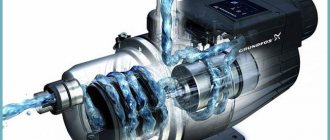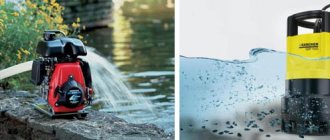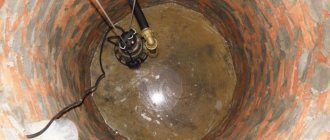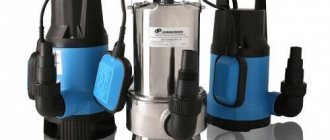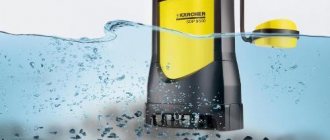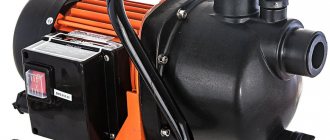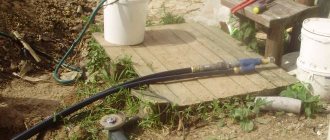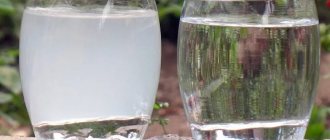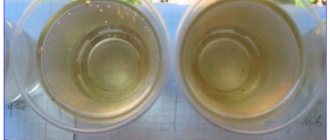Installation in a well
Installing a submersible pump in a well is not the most complicated procedure, as the following video shows, for example:
Step-by-step instructions:
Excavation
The installation of a winter water supply system should begin by preparing a trench for laying it from the well to the house. The bottom of the trench must be carefully leveled, freed from sharp protruding stones, and covered with a sand cushion at least 10 cm thick.
Preparing to enter the pipe into the well
You need to prepare a neat hole in the concrete ring. Taking a piece of pipe of short length, attach an elbow at one end of it, which will be connected with a flexible hose to the outlet pipe of the pump. At the other end, strengthen the coupling for the main pipe. After inserting this workpiece into the well, it should be securely fastened, and the hole should be carefully sealed, preventing penetration into groundwater through it.
Laying water pipes
In the same way, you should prepare the entry of the pipeline into the house. Then, cutting off the pipe of the required length, lay it in the prepared trench, connecting it with couplings at the entrance to the well and into the house. The electrical supply cable should be laid in a plastic pipe to avoid damage.
Installation
It is better to connect the device to the pipeline inside the well using a flexible hose to make it easier to lift it to the surface for maintenance and repair work. If the outlet pipe does not have a check valve, it must be purchased and installed separately.
To suspend the apparatus in a well, it is necessary to firmly fasten a piece of metal profile to its upper ring, to which the holding cable will be attached.
The pump should not be located at the very bottom, but not less than 1 m from it. To lift it to the surface, you can provide a gate, winch or other mechanism.
The electrical cable on the device suspension should not be taut and have a slight slack.
Under no circumstances should the unit be suspended by either the electrical cable or the water outlet hose.
Connecting the hydraulic accumulator and automation
Having completed all external work in the trench and well, you can connect the pipe to the hydraulic accumulator at the inlet of the home water supply.
The connection must be made through a shut-off valve. It is also a good idea to install a “dry running” relay in the system, which protects the device from damage if there is no water in the well.
It is also worth installing coarse and fine water filters to remove iron at the inlet of your home water supply.
For more information on how to connect a submersible pump to a hydraulic accumulator, watch the video:
https://youtube.com/watch?v=gKOnfoGzKVU
Who should do the installation
As you can see, installing pumping equipment is not that difficult. In order to do everything quickly and correctly, 2-3 people are enough. However, situations are different. And if it is not possible to do everything yourself (or you simply doubt your abilities), you can invite professionals.
If you hire people to install a submersible pump in a well, the price for the work can be very different. It largely depends on the depth of the well and its distance from the house.
Conclusion
Installing pumping equipment for a well is not such a difficult task. The main thing is to try to strictly follow the instructions.
In addition, before starting work, carefully read the device manufacturer's recommendations regarding its location and connection.
Watch a video explaining the technology of work.
How to hang and secure with your own hands
To prevent the device from ending up at the bottom during operation, it is necessary to securely fasten it with a hose to the wall of the shaft on a metal structure.
- A square-shaped frame with brackets at the corners for fixing to the wall is made from a steel corner using a welding unit.
- Two channels are welded along the diagonals of the square, and a hole is made at their intersection.
- The frame is rigidly fixed on top of the mine casing using brackets.
- A steel cable is passed through the hole in the channel, and a loop is crimped at its end to hold it on the structure.
- The pump is suspended from the safety rope and is used to remove it from the well.
This option of hanging the unit in the shaft guarantees the safety of the device.
Rules for installing the surface version
Surface pumps are not often used for this type of water supply as they are only suitable for shallow hydraulic structures, up to eight meters deep.
And yet, this option has a right to exist, and its installation is no more complicated than installing submersible equipment.
Surface pumps are easier to install and cheaper than submersible models, but they are only effective for wells up to eight meters deep
Mount the device as follows:
- The surface pump is installed in a special caisson or a separate room.
- A hose of suitable length is connected to the suction pipe of the pump.
- A check valve is attached to the other end of the hose (a protective measure to prevent water from draining when the pump stops running).
- A protective strainer is installed on the valve to prevent various contaminants from entering the pump housing.
- The hose is lowered into the well.
At this point, the installation can be considered complete and a test run of the pump can be done. To install such a pump in a well, a special adapter is often used. In this case, the hose is connected to the adapter, and the adapter is connected to the pump. The rest of the installation procedure is exactly the same.
It is a little more difficult to install a surface pump equipped with a remote ejector into a well. In this case, two hoses need to be lowered into the well. In addition to the suction hose, a pressure hose is also installed. It is connected to the side fitting of the ejector using a special outlet.
In addition to the check valve and filter, an ejector must also be installed at the end of the suction hose. It should be remembered that surface pumps are very sensitive to contaminants in the water supplied from the well.
Step-by-step instruction
- First of all, it is necessary to find a pressure pipe at the pumping unit, to which the pipeline is connected, through which the wastewater will be pumped out. The clamp is carefully tightened at the connection point using a screwdriver or pliers.
- Most models are equipped with a float switch. If it is present in the model you choose, then a check valve should be installed on the connected pressure hose, which will prevent water from flowing back into the tank.
- Immediately before installation, you need to check the operation of the unit. Carefully read the instructions for it, manufacturers' recommendations and certificates. Another important point is determining the direction of the shaft. To do this, a household drainage pump is installed on a table or floor and connected to the network. If the movement is to the right, it means the equipment is working correctly.
- The pump unit must be installed exclusively in a vertical position. Make sure that the pressure hose is also directed vertically. Its end is directed into a container where the liquid will subsequently be pumped.
- Finally, the pump is sunk to the bottom of the tank and connected to the power supply.
With automatic
The best option is a water supply system that operates fully automatically. However, such a solution will increase the price of the equipment. This saves the owner from the need to frequently manipulate the switch when water is needed.
Operation of equipment in this mode is not accompanied by pressure surges and water hammer, which can cause problems in the operation of household appliances
It is important to ensure that the pumping station controls the water level in the source, taking the necessary measures to prevent its depletion
To implement this idea, certain elements will be required:
- float switch;
- pressure switch;
- storage tank.
The key role in the correct setting of the device, which must be equipped with a well pump, is played by the float switch. Its main task is to turn off the equipment at those moments when the water level drops below the dynamic and permissible level, which avoids emptying the well.
The best option seems to be universal floats, offered at different prices, which do not have a direct connection to other devices. Their design includes a two-phase or three-phase switch and a relay that is triggered by the position of a small flat float when its location changes relative to the main body of the device. The relay is activated at the moment when the float drops below the set level following the water surface, which leads to de-energization of the pumping apparatus. When the water level is restored, the relay re-energizes.
Features of choosing automation
Despite the simple design and low price of relay float switches, in order to operate, it is necessary to connect a power cable to them and back to the pump, which is why the length of the wiring becomes critically large and it is necessary to use a food-grade wire, which must be partially lowered into the water. This solution is best suited for equipment that is located in a caisson next to the well.
But it is advisable to abandon this option if a place is chosen for the pump that is located at a considerable distance from the well. For this purpose, signal floats should be used, which can only provide a control signal. In this case, it is permissible to allocate a place next to the equipment to place the power relay.
To create a pumping station, the following devices must be present:
- pressure switch;
- storage tank.
The operation of the system begins with the supply of water to the storage tank, where there is a membrane; it is filled with water until the required pressure is created. Once there is enough water, the pump is turned off. If access to water is provided by the consumer, then the liquid contained in the tank will first be consumed. And only when the pressure drops below the set threshold, the relay will give a signal to turn on the pump. When the required pressure is created in the tank again, the upper threshold relay will give a corresponding signal and the pump will stop working. Such a cyclic mode will ensure a constant supply of water to the house, without resorting to frequent activation of the pump.
Connecting the pumping station
As mentioned above, the system is simple: a pipe is immersed in a well or well (usually polypropylene 32 mm, but sometimes 40 mm - depending on the performance of the pump). It is supplied to the station input, and from the output it is supplied to the water supply comb.
- Do everything so that unnecessary branches can be blocked.
- Provide for the possibility of draining water for the winter. Since the system must have a check valve, it is necessary to make the outlet a little higher.
- Install shut-off valves at the inlet and outlet of the pumping station. By blocking them, it will be possible to remove the equipment for maintenance without much difficulty.
Since most of the system components are stationary, all elements are connected using American nuts with union nuts. Otherwise, it is very, very difficult to assemble and then disassemble if necessary.
Detailed connection diagram of the pumping station. Implemented a system for displacing air from pipes and equipment
One of the pumping station connection diagrams is shown in the photo. The purpose of most elements is clear, with the exception of the “cut-off 1” and “cut-off 2” valves. They are used when filling the system during the first start-up. Here's how the process works:
- The cut-off valve 2 and the drain valve are open, the cut-off valve 1 is closed. With this position of the valves, pouring water into the corresponding inlet, we fill the lower part of the system. Some of the air escapes through the drain valve.
- Now close “cut-off 2” and the drain valve and turn on the pump for 5-7 seconds. After 5 seconds, open “cut-off 1”. In this way, increased pressure is created in the system, which squeezes air out of the system (a couple of taps must be open).
- Second startup cycle: “cut-off 2” valve is open, “cut-off 1” and drain valve are closed. Turn on the pump again for a short time.
- After 5-7 seconds of pump operation, open the “cut-off 1” valve. The system should start. If there is still a lot of air left, you can repeat the second starting cycle.
In working condition, “cut-off 2” and the drain valve are closed, “cut-off 1” is open.
In this scheme, more attention was paid to purification - there is a fine filter at the entrance to the house
This system is interesting because of its well-thought-out cleaning system: a water filter is installed on the branch that goes into the house. As a result, we have clean water without impurities in the tap.
How to make a shower in a bathhouse with your own hands, read here.
Do it yourself or hire specialists?
Having considered how to hang a pump in a well, we can highlight several points with which difficulties arise:
1.calculation of dynamic water level;
2.fastening the support frame inside the well ring at a depth of 1.5 meters or more from the ground level;
3. fastening the cable to the support frame
4. laying pipes and installing joints.
Considering the above, it is better to entrust the installation of the pump in the well to people who do this professionally. In this case, you can be 100% sure that your pump will not burn out from running “dry” or pulling sludge from the bottom, the pipe joints will not leak, and everything will work perfectly.
Distinctive features
Pumping equipment for dirty water belongs to the drainage category, and its use is similar to the use of fecal pumps. However, there are some differences:
- To a greater extent, fecal units are designed for viscous wastewater with fibrous organic inclusions, for the pumping of which a grinding mechanism is provided.
- The drainage pump, on the contrary, is not designed to operate in liquid conditions saturated with organic inclusions. At the same time, a drainage pump for sewage allows you to pump wastewater containing insoluble large fragments - pebbles, sand, silt of a certain size. As a rule, the permissible size of inclusions is indicated in the product passport.
Preparatory stage of pipeline laying
At this stage, you will need tools for excavation work, pipes of the required diameter, connecting elements for plastic pipes or a welding machine if the pipeline is metal.
Excavation work - trench preparation ↑
When designing a water supply for installing a pipeline, it is better to choose an area where the pipes will be laid in a straight line, without bends or turns. This is desirable for several reasons:
- there will be less work;
- a straight pipeline will provide higher pressure in the system;
- During installation, fewer connections will be made, which means the risk of leaks will be reduced.
First you need to dig a trench with a depth below the freezing level of the soil (about 1-1.5 m) and a width of about 0.5 m. The bottom of the finished trench is cleared of foreign objects. After this, they are covered with a layer of sand 10 to 20 cm thick. The sand cushion is covered with a layer of geotextile fabric. After installing the plumbing, they will need to wrap the pipes.
How to properly lay a water supply ↑
There are two types of pipes that are suitable for installing water supply systems: metal and polymer. Among metal ones, it is better to give preference to stainless steel, and among polymer ones, plastic or polypropylene is most often chosen. Sometimes a garden hose is connected to the pump, but this option is only suitable for organizing a temporary summer water supply.
The pipes are laid along the trench and connected. It is advisable to insulate the finished long water pipe. To do this, it is wrapped in a heat insulator and placed either in an asbestos pipe or in a large-diameter sewer pipe. This design guarantees the resistance of the water supply system to external influences. It is placed in a trench.
The wall of the well is pierced to introduce a water supply pipe. A sleeve is inserted into the hole, fixed with concrete, and sealed. After this, a layer of bitumen mastic is applied for waterproofing. The end of the water pipe is inserted 25 cm into the sleeve, and a tap is placed on it in case of emergency drainage of water. All that remains is to measure the distance from the tap to the pump and prepare a pipe of the same length.
Selection of power and model
Even a small and low-power installation can provide solid performance, sufficient to supply water to several consumers. Arguing about the merits of this or that brand is completely useless - it’s like discussing cars. Everyone has their fans.
The main factor affecting performance is the storage volume - the pump operates intermittently. Its task is to pump water into the accumulator as soon as the pressure drops below a predetermined level.
But the water flow and pressure in the network are supported by a hydraulic accumulator. Consequently, the larger it is in volume, the less often the automation operates, the less the starting load on the engine.
It should also be taken into account that half the volume of the storage tank is occupied by compressed air, which provides pressure in the system and displaces water. Consequently, only part of the tank volume is filled with water. And, when the pump is turned off, the consumer can only rely on it.
The required volume depends on many factors: the number of residents, installed equipment, and so on.
But schematically it looks like this:
- one or two people or a cottage, where there is only one washbasin or a primitive shower - the volume of the hydraulic accumulator is 24 liters;
- three or four people should already be looking at sizes of 50 liters or more;
- over 5 people - minimum tank volume 100 liters.
In addition to the performance characteristics that should definitely be taken into account, there are optional options. For example, the presence of a dry start relay
It is not necessary in the design, but under certain conditions it is quite capable of extending the life of the station or preventing its breakdown. Unfortunately, it slightly increases the cost and complexity of the system.
When selecting a model, it is worth considering the horizontal water transportation distance and lifting height
Arithmetic calculations
When calculating the required power of pumping equipment, it is important to consider that 1 meter of vertical length corresponds to 10 meters horizontally. The rate of liquid removal will be low, despite the fact that the drainage units operate under conditions of constantly rising water. In order for the installation of a drainage pump to be justified, it is necessary to add to the height of the rise of the drains the length over which the discharge pipeline will be laid horizontally along the surface of the ground.
Types of pumps
The following types of water pump in a well are distinguished:
- Borehole. Such devices have a small diameter. In addition, they do an excellent job in cases where the water contains clay or limestone. This type is excellent for high pressures and significant distances between the water intake point and the consumer.
- Wells. Such a water pump is not completely immersed in the well. The water intake hole is designed at the bottom, the engine is cooled by liquid. Some models are equipped with a shut-off system when there is no water.
- Vortex. By their type, such aggregates are classified as surface. Their advantages include a relatively low price and compact size. In addition, if the water in the well contains various impurities, the vortex apparatus may not cope with its task.
- Centrifugal. Such devices are capable of drawing water from depths of up to 9 meters. Installing a pump in a well of this type has a significant advantage - their operation does not fail when a plug forms from the air.
The first two types of pumps are classified as submersible. They also require a special SQE package - an automation kit for the units. The pressure and other characteristics will be regulated by the equipment independently.
What is a clean water drain?
It is designed to pump out lightly polluted reservoirs, pits, wells and other things. Some types of submersible pumps are capable of pumping liquid with inclusions up to 40 mm in diameter. It is not recommended to use pumps for purposes other than their intended purpose, such as pumping feces. It will fail.
The drainer is capable of working exclusively in lightly polluted places. If the pumped liquid contains large inclusions, then the equipment must be equipped with a grinder; by default it does not have this.
Choosing a device for a well
For as many years as individual developers have been installing home water supply systems, the debate has been going on about what type of pump to use for this: surface or submersible.
In this article we will talk about submersible ones, so it is worth briefly noting their main advantages:
- They are capable of operating at great depths, because, constantly being under water, they immediately work to push out and lift water, unlike surface pumping stations, which also have a suction area not exceeding 7~8 m.
- They have efficient water cooling, therefore, with equal surface dimensions they can provide greater power.
- They do not require pre-filling the system with water before use or after winter storage.
- They do not require special conservation measures or additional insulation for the winter.
- They have a low noise level.
- For these reasons, there is no need to allocate additional noise-proof and insulated premises for installation.
Among the disadvantages of submersible pumping devices, it is worth noting only the need to rise to the surface for preventive and repair work.
Among all the types of submersible units, two main ones can be distinguished:
Vibrating
The principle of their operation is based on oscillations in the alternating magnetic field of the core created by a powerful solenoid, driving a membrane that creates excess pressure at the outlet of the device. Summer residents have long known such models as “Baby”, “Rucheyok”, etc.
Among the main disadvantages of such devices, the following should be noted:
- Low performance.
- Constant vibration in the well, which over time can significantly compact the surrounding and bottom soil, significantly reducing the flow of water into the well.
Centrifugal
Thanks to good performance in a compact size, as well as an affordable price, they have become one of the most sought-after and popular pumping equipment on the market. Depending on the design of the blades, they are divided, in turn, into:
- turbines with lateral or axial blades;
- rotary;
- screw, having a screw mechanism for lifting water, known since the time of Archimedes.
In addition to productivity, centrifugal devices have other advantages:
- simplicity of design;
- high reliability;
- efficiency.
Choosing a pump for a well
- choose exclusively from downhole-type centrifugal units, since other types, in particular vibration, are intended for other operating conditions. The price of such devices is the lowest on the market, and the quality is correspondingly the same;
- One of the most important characteristics is the performance of the pump, which, first of all, must meet your needs. By performance we mean the number of liters of water that the device can pump in one hour. You need to rely on a level of productivity that will ensure an uninterrupted supply of water to the target locations;
- Also, the diameter of the pump housing is considered important. This value must correspond to the internal diameter of the casing pipes, which are the walls of the well. Here it is necessary to take into account that the closer to the bottom of the well, the smaller its diameter.
How to decide on the type of pump
If you want to organize water supply for a country house or summer cottage by digging your own well, you must also take care of the method of extracting water from it. This problem is most easily solved using an electric pump. Before purchasing a suitable model, it is necessary to formulate the technical requirements for the unit, which will be discussed in this section.
Submersible or surface well pump
There are two main types of pumps available for domestic use: submersible and surface pumps. Their choice is largely determined by the depth of the well and the level of the water surface relative to the surface of the earth.
Surface pumps are installed on specially equipped sites or in utility rooms. To collect liquid, they are equipped with a receiving pipeline with a check valve that prevents spontaneous emptying of the system. At the moment of start-up, the impeller rotating at high speed creates a vacuum, sucking water from the well, which is then pushed out through the pressure fitting at high pressure.
Surface pump installed near the well.
Theoretically, the possible suction height of such pumps cannot exceed 10.3 meters. In real conditions, depending on the design features and manufacturing quality of the pump, it reaches 5-9 meters. To reduce the distance to water, such units are installed in the immediate vicinity of the well neck or inside it on rigid supports or a floating raft.
Surface pump installed inside the well.
Option to install a surface pump inside a well.
The advantages of such models:
- relatively low requirements for the tightness of the structure and the quality of the materials used;
- affordable price;
- easy maintenance.
There is a way to extract water with a surface pump from a depth of 25-40 m using a lowering ejector. At the same time, the piping of the unit becomes more complicated and a significant part of the power spent on the operation of additional equipment is lost.
Pumping station with a remote ejector.
Submersible pumps are lowered directly into a well or other body of water used as a source of water. They do not have problems associated with suction and the risk of jet rupture, but there is a possibility of picking up soil particles or plant debris. They are usually equipped with a receiving mechanical filter. The housing of such units is made of expensive stainless steel, and all current-carrying elements are placed in a sealed casing.
Strengths of this equipment:
- no problems with filling and suction;
- easy start;
- compact sizes.
During operation of the submersible pump, it is necessary to monitor the condition of the receiving grid and prevent dry running if the liquid level drops.
What you need to know about pump performance
Pump performance shows the maximum amount of water it pumps per unit of time. It is expressed in m3/hour or l/min. At the factory it is determined under ideal conditions for the equipment. In reality, the flow rate strongly depends on the hydraulic resistance of the system, which is usually displayed in the performance graph attached to the passport.
When choosing a unit for a well, they are guided by the number of residents and plumbing fixtures, including the needs for watering the garden. Sometimes the decisive role is played by the fluid replenishment rate associated with the throughput capacity of the aquifer. Pressure tanks with water reserves or hydraulic accumulator tanks included in the pumping stations supplied by the manufacturer help smooth out peak loads when using not the most powerful models.
Pump head
The pump head is expressed in meters of liquid column. It is equal to the maximum height to which it can be raised, although the consumption in this case will be minimal. In a stable pumping mode, pressure is spent not only on overcoming the difference in elevations, but also on the hydraulic resistance of the pipelines and the fittings installed on them.
Pump efficiency
The efficiency of a pump, like any other mechanism, shows the ratio of useful work to the amount of energy expended. The higher it is, the more economically the equipment is operated, the lower the payment to power engineers will be. This indicator depends not only on the design of the machine pumping liquid, but also on the chosen water distribution scheme in your home. Typically, for submersible units it is slightly higher than for surface ones, since they do not have to waste energy on suction.
Working conditions
Despite the fact that drainage pumps easily cope with pumping wastewater, their technical characteristics are limited by the degree of contamination of the liquid. It is important that this parameter does not exceed acceptable values.
A high content of sand, large stones, dirt, or silt may adversely affect the operation of this device. That is, the installation of a drainage pump in the basement may be intended to eliminate flooding, but if it is necessary to drain the reservoir, a solid platform with a flat surface is placed under the bottom of the unit. If the work area is a construction site, then the best option would be a powerful fecal pump with a grinding mechanism.
